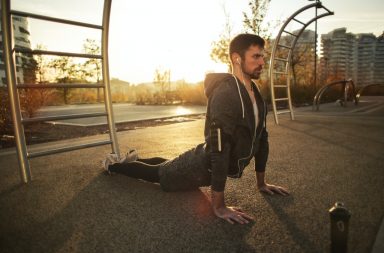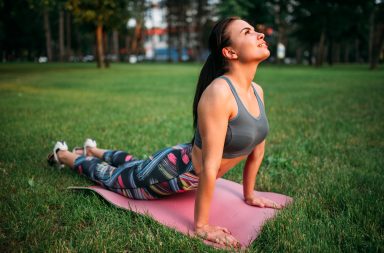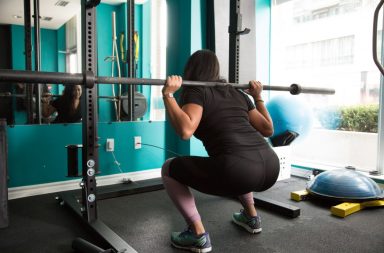With how much information there is out there on the benefits of exercising, even the most reluctant person will feel compelled to get involved. But sometimes, due to one reason or the other, things cannot always go as planned. Knee problems, for example, can be incredibly annoying as they come with various degrees of pain, and it takes ages to heal. Put simply, knee pain is a huge obstacle to your keep-fit regime, especially if you’re wondering how to exercise with bad knees to lose weight. Thankfully, you don’t need to lose hope as there are many ways you can still workout with sore knees, and that’s what this article is all about. We will take you through some simple bodyweight leg exercises that will give you a great workout while protecting your bad knees.
The following knee-friendly leg exercises take the pressure off the knees so that you’re less likely to do more damage to them.
1. Low Plank Hold With Knee Flex
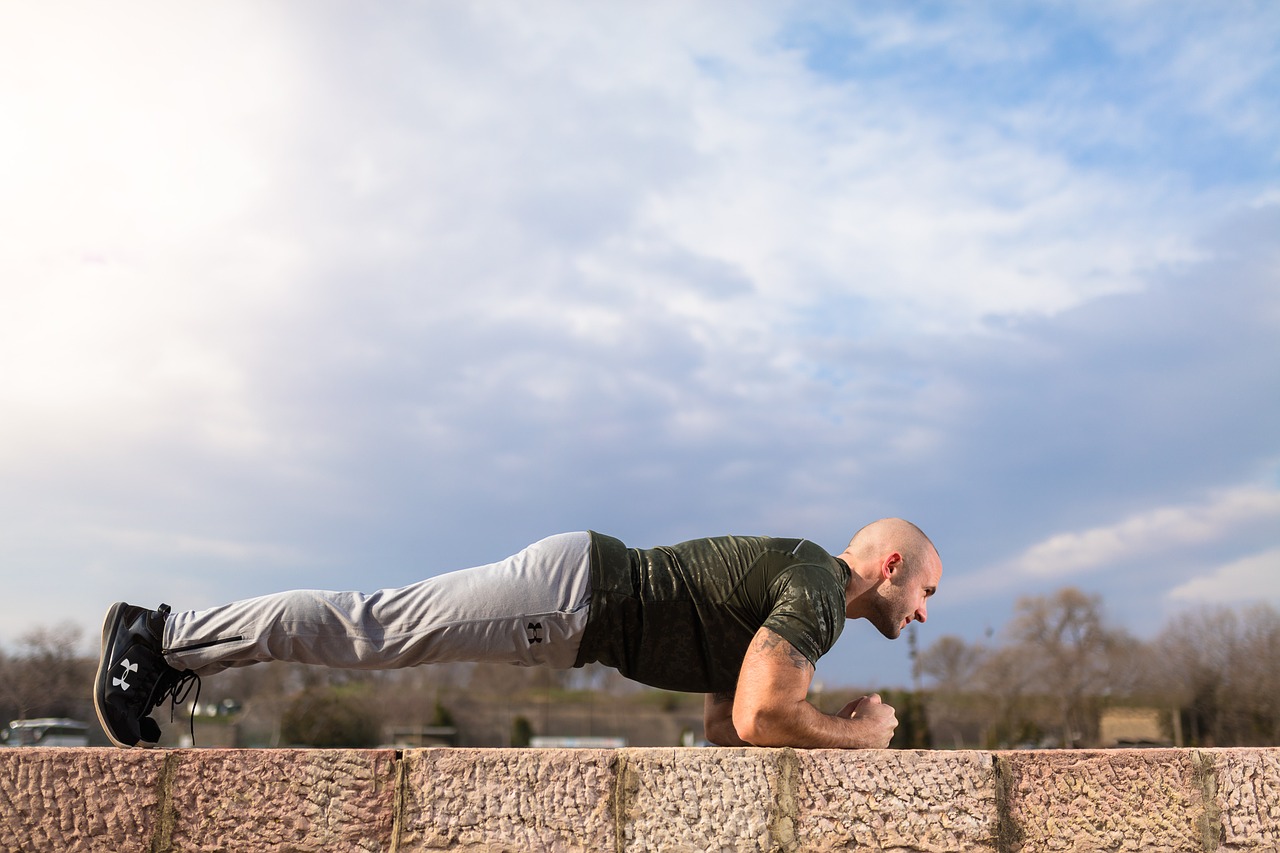
Photo credit: victorious_fit / 4 images
While walking and jogging allow you to work on the quads and hamstrings separately, this one allows you to do both at once. So if you’re thinking ‘how do I strengthen my legs with bad knees’ well here’s how you can do it. You won’t need any equipment, and you’ll be able to work your core as well.
First, lower your body into a plank position on your elbows. Then slightly lift one leg off the floor and flex your knee with your heel against your glutes. While holding up your legs and hips, gently drop the leg and repeat. Do this about eight to twelve times in two or three sets, alternating from each leg.
2. Wall-Facing Chair Squats
Squats, in general, don’t work so great for the knees and so this is a better alternative. All you’ll need is a standard table chair with a comfortable height for you to sit down, and you’ll have to be facing a door or wall. The distance between you and the wall should be one foot, with the chair behind you.
While your feet are hip-width apart and parallel, gently lower yourself into the chair. Try not to plop, or else you reduce the effect of the exercise. Also, remember to brace our core throughout the movement. From the seating position, lower yourself into the floor through your legs, and then stand back up, locking out your hips into position.
3. Kettlebell Swing
This exercise is a simple yet effective way to work your glutes, hamstrings, and back muscles without putting excessive pressure on your knees. You’ll need a kettlebell for it.
The first step is to get into position, with your legs shoulder-width apart. Then bend yourself down, using both hands to grip the kettlebell. With your knees bent, swing from the low position up till the bell is at the chest height. Then swing it back down, ensuring it doesn’t get too far back between your legs since that may cause you to squat too low on your knees.
4. The Deadlift
Don’t let the name intimidate you because it will help in the long run. It works your core muscles, glutes, and hamstrings, and you can use dumbbells or a single barbell.
Get in position with your knees slightly bent and your feet shoulder-width apart and pick up the weight(s). Then bend forward at the hips to drop them back to the ground. Try to keep your chest proud, preventing your shoulders from rounding. Take a pause and then get back to the starting position and repeat.
5. Bodyweight Squat With Knee Press Out
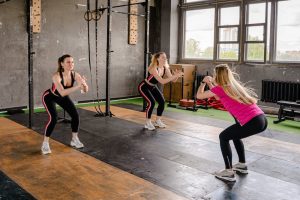
Photo credit: Anthony Shkraba
This workout is a squat but with slight modifications to make sure your knees are protected. You will need a resistance band, preferably 20 inches, to go through the process.
Get into position with your feet shoulder-width apart and secure the resistance band right above your knees. Your toes should be slightly open, and your arms stretched out in front of you at the shoulder to chest height. Then with bent knees, lower your hips and back until you have the top of your thighs parallel to the ground.
While you’re at it, remember to keep your knees outwards so that the band is still stretched. Your knees should also be right above the ankles. The pressing unto your heels, get back up into a standing position. Do preferably about 15 of these or otherwise how much your body can take in a session.
6. Lateral Band Walks
If you’re asking yourself, ‘how can I build my glutes with bad knees,’ well, your answer is right here. This exercise is quite simple, and all you’ll need is a 20-inch resistance band as well. It targets the hip, glutes, and butt muscles with some muscle activity in the legs as well.
Place the resistance band around your knees, right below or above it depending on what you prefer. Then get in a squatting position but not all the way so that you are in a quarter squat. Then take a significant step to the right and follow it with your left leg. Continue this movement about 10 to 15 times or as much as your space will allow. Then proceed in the opposite direction, and then return to the starting position.
7. Hamstring Roll-Ins on the Stability Ball
This workout requires a mat and a stability ball and works on your hamstrings, back, glutes, and core.
Start by laying on your back on the mat with your hands beside you and place your legs on the stability ball. With only your head and shoulders relaxed on the mat, squeeze your glutes and abs and raise the rest of your body off of it. Then using your heels, roll the ball in and back out slowly as many times as you can and then lower your body back onto the mat.
How The Knees Work (The Science Bit)
Let’s take a quick look at how your knees function.
The knee represents the joint behind the kneecap between the thigh bone (femur) and the shinbone (tibia). It also consists of tendons and ligaments to keep the bones and muscles in place, and protective cartilage over the joint. The causes of a bad knee vary and include pain from an injury, degenerative joint disease, arthritis, osteoporosis, or carrying excess body fat. Your quadriceps and glutes which offer support above the knee could be weak. Bad knees could also be as a result of weak calves, which are the bottom support for the body part.
To Summarise
One key thing to remember about exercising is to start small and level up from there. With bad knees, you’ll have to be extra careful not to worsen the problem. Before starting any of these exercises and if you’re unsure about what’s causing your knee pain, you may want to speak to a professional and get hold of some physiotherapy exercise for knee pain. A physio can also inform you about what exercises not to do with bad knees. You can also consider contacting an orthopaedic doctor who may diagnose your condition and provide a long term surgical solution.
I hope you’ve found this post particularly useful if you’re trying to keep fit while dealing with the hassle of knee pain. If you enjoyed this read, why not also take a look at our previous articles on upper body exercises that will of course put zero pressure on your knees. Let us know your thoughts by leaving a comment, and if you want, spread the word by sharing this article with someone who will benefit from the contents.
